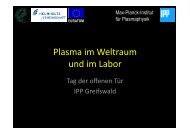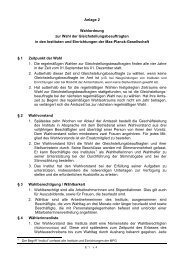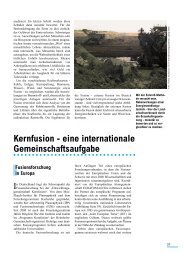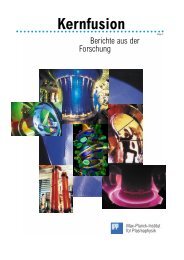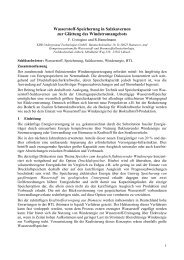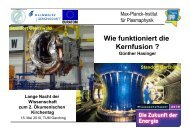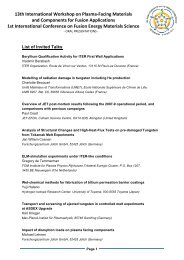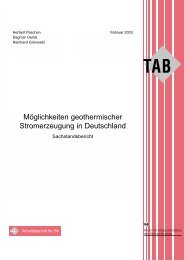IPP Annual Report 2007 - Max-Planck-Institut für Plasmaphysik ...
IPP Annual Report 2007 - Max-Planck-Institut für Plasmaphysik ...
IPP Annual Report 2007 - Max-Planck-Institut für Plasmaphysik ...
You also want an ePaper? Increase the reach of your titles
YUMPU automatically turns print PDFs into web optimized ePapers that Google loves.
While for the ITER wall the mode coupling is negligibly small,<br />
the complex structure of the additional AUG wall segment leads<br />
to a significant coupling of the n=1 and n=2 toroidal harmonics.<br />
Furthermore, the feedback optimization code OPTIM has<br />
been supplemented with a robust control package. Eigenvalue<br />
sensitivity is now taken into account by the concept of<br />
pseudospectra. The computed feedback controllers are optimally<br />
robust with respect to, e.g., model imperfections, and<br />
transient amplifications of initial perturbations are kept at a<br />
moderate level.<br />
Preliminary investigations indicate that both robustness and<br />
transient growth could be a severe issue when attempting to<br />
stabilize RWMs in ITER.<br />
Kinetic MHD and Fast Particle Physics<br />
A comprehensive and self-consistent kinetic investigation of<br />
global fast particle driven modes in tokamak plasmas below<br />
the toroidal Alfvén Eigenmode (TAE) frequency requires<br />
the inclusion of the bulk ion compressibility. This extension<br />
enables the linear gyro-kinetic eigenvalue code LIGKA to<br />
analyse the low-frequency properties of the Alfvén cascade<br />
modes (AC), the beta-induced Alfvén eigenmodes (BAE)<br />
and the energetic particle modes (EPM). Furthermore, also<br />
the linear phase of micro-instabilities like ion-temperaturegradient<br />
modes, trapped-particle modes or micro-tearing<br />
modes can now be described with LIGKA. Thus, it closes<br />
the gap between global low-n MHD descriptions and high-n<br />
micro-scale turbulence codes (in their linear phase). As an<br />
application, the kinetic damping mechanisms of the resistive<br />
wall modes have been investigated. It was found that not<br />
only the sound wave damping near the rational surfaces contributes<br />
but also the coupling to the electrostatic drift branch<br />
modifies the mode structure and therefore modifies the<br />
damping rate.<br />
Linear MHD Stability Analysis<br />
Within the Integrated Tokamak Modelling effort (IMP#1), a<br />
matching suite for optimized linear MHD stability analysis<br />
has been created by improving and adapting the converter<br />
tool RWSHOT for experimental shotfiles, the fixed boundary<br />
equilibrium code HELENA, and the linear MHD stability<br />
code ILSA.<br />
It is now possible to calculate the linear MHD spectrum of<br />
edge modes vs. their toroidal mode number starting from<br />
free boundary equilibria generated by the equilibrium codes<br />
CLISTE and EFIT, thereby facilitating comparison of most<br />
major tokamak devices in the fusion community. In the light<br />
of this new possibility, benchmarking studies of edge stability<br />
have been carried out at DIII-D and ASDEX Upgrade,<br />
highlighting the influence of near-X-point geometry on the<br />
stability of the peeling-ballooning mode. While there is<br />
good agreement on the stability of the ballooning term,<br />
results with respect to the pure peeling and kink terms<br />
Theoretical Plasma Physics<br />
82<br />
remain inconclusive due to numerics limitations in the<br />
vicinity of the X-point. Further, potentially analytical, effort<br />
is needed to elucidate on the relevance of the peeling mode<br />
in strongly sheared geometries.<br />
Non-linear MHD Studies<br />
The locking of neoclassical tearing modes (NTMs) by error<br />
fields was studied numerically. In the regime with low mode<br />
frequency and large plasma viscosity, the required field<br />
amplitude for mode locking is found to be proportional to<br />
the plasma viscosity and the mode frequency but inversely<br />
proportional to the square of the magnetic island width and<br />
the Alfvén velocity, indicating that NTMs will be locked to<br />
low amplitude error fields in a fusion reactor. The stabilization<br />
of NTMs by RF current in the presence of a static helical<br />
field was therefore further investigated. The applied helical<br />
field allows controlling the location of the island’s o-point<br />
to be in the RF wave deposition region, to enable the NTM<br />
stabilization by RF current after mode locking. When the<br />
island is large enough to be locked by a small amplitude helical<br />
field in the desired phase, the island is reduced to a<br />
smaller width by RF current compared to the case without<br />
the helical field. This suggests a possible way to enhance the<br />
stabilization of NTMs by RF current.<br />
The error field (or externally applied helical field) penetration<br />
was studied numerically based on the two fluids equations.<br />
It was shown that there is a minimum in the required<br />
field amplitude when the applied helical field frequency is<br />
the same as the mode frequency being determined by both<br />
the background equilibrium plasma rotation and the diamagnetic<br />
drift. The mode penetration threshold significantly<br />
increases as the field frequency deviates from the mode frequency<br />
and can become asymmetric on both sides of the<br />
minimum due to parallel transport. After mode penetration,<br />
the non-linear saturated island width is found to be smaller<br />
for larger electron diamagnetic drift frequencies.<br />
Transport Analysis Group<br />
In the field of core transport, work has been dedicated to<br />
understanding the central behaviour of Si laser ablated impurities<br />
in response to localized central electron heating in<br />
AUG H-mode plasmas with a background of NBI heating.<br />
The Si impurity central profile flattens in response to central<br />
electron heating up to exhibiting a hollow profile which cannot<br />
be explained by neoclassical theory. The gyrokinetic<br />
code GS2 has been used to calculate the turbulent transport<br />
of the Si impurity under these experimental conditions.<br />
It has been found that in the presence of strong central electron<br />
heating, modes rotating in the electron diamagnetic drift<br />
direction are destabilized in the central region of the plasma,<br />
generated by the non-adiabatic response of passing electrons<br />
and featuring extremely elongated eigenfunctions along<br />
the field lines. The related fluctuations in the electrostatic




